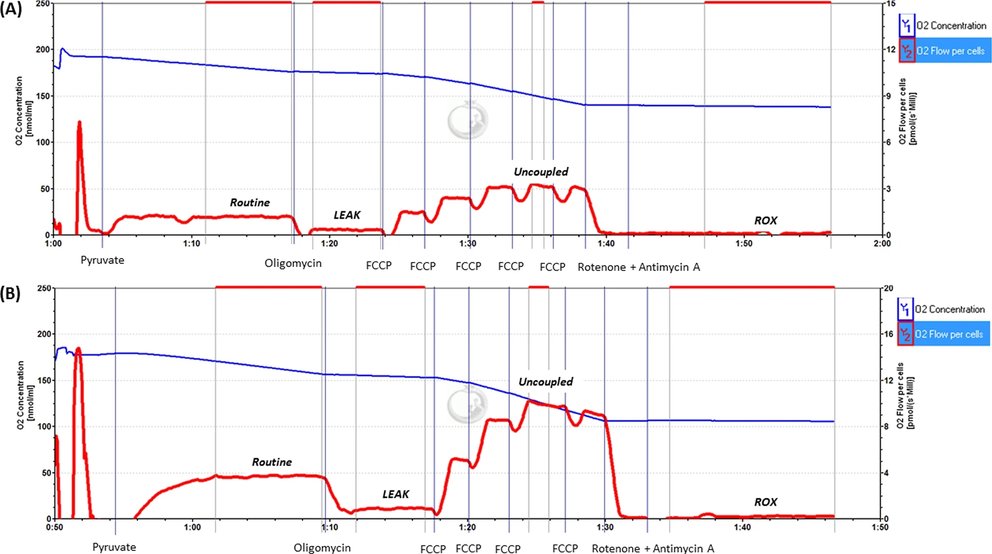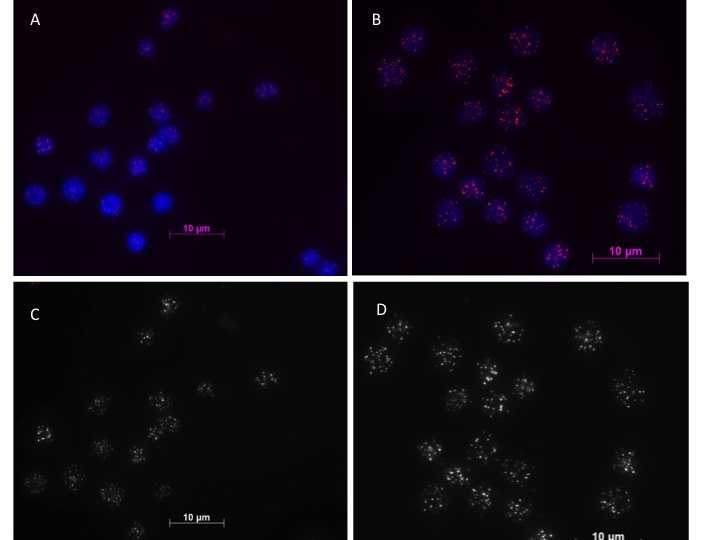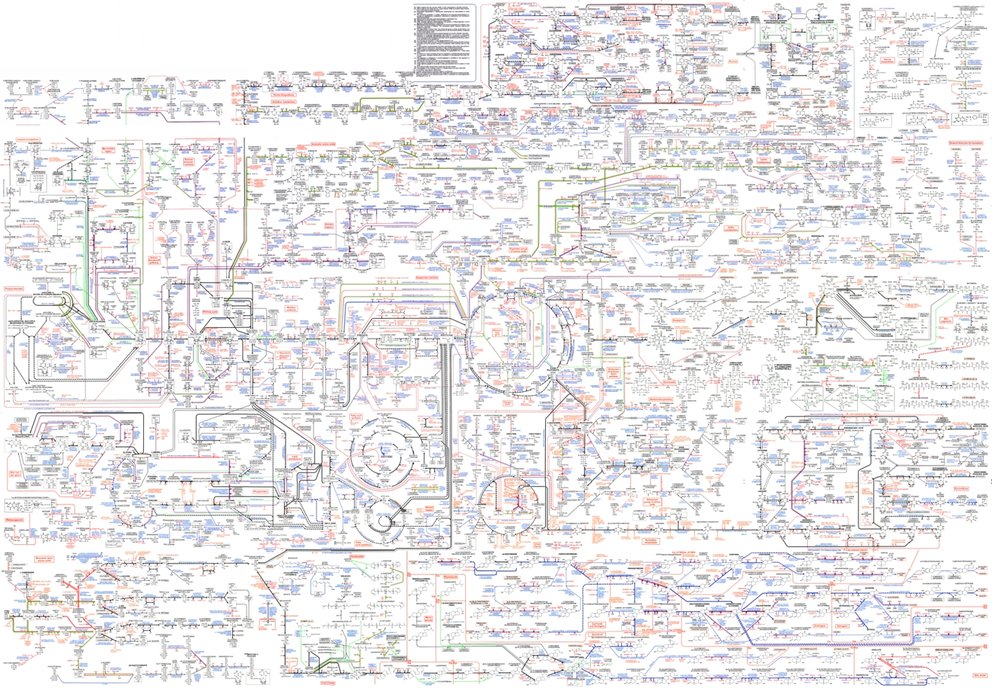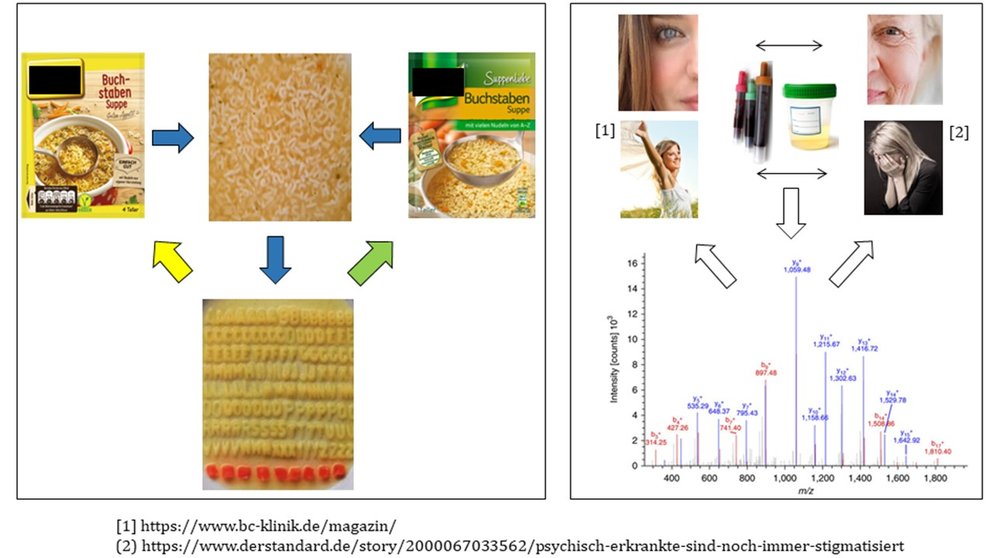Research focus
Presentating selected aspects of our research focus
The task of the research group "Biomolecular Psychotraumatology and Stress Research" is to identify the biological changes and pathophysiological processes following chronic and traumatic stress and to characterize the possible reversibility of these changes through clinical interventions, e.g. psychotherapeutic procedures. For this purpose, we use methods and perspectives of psychoneuroimmunology (PNI), some selected aspects of which are presented here.
Investigation of biochemical and bioenergetic changes of mitochondrial activity in immune cells using high-resolution respirometry
Physical and also psychological stress forces the body into an adjustment reaction, which is also associated with an increased energetic challenge. For example, the body's cells must provide higher availability of adenosine triphosphate (ATP), which is made available via the mitochondria in the cells. Mitochondria, the "powerhouses of the cells", are much more than just a synthesis site for ATP. They are also involved in the biosynthesis of steroids (e.g. cortisol) and the availability of neurotransmitters (e.g. MAO-A), and they are sensitive to physiological stressors and biological allostatic loads (including free radicals and oxidative stress, changes in pH) that pose a threat to cellular integrity. As regulators of apoptosis, they can thus also determine the fate of stress-damaged cells. Short-term stress and its stress-associated biomolecular consequences are usually reversible. Chronic and traumatic stress, however, can lead to physiological changes associated with the biological effects of aging (shortening of telomere lengths, epigenetic aging profiles, epigenetic clock) and their consequences for physical and mental health.
High-resolution respirometry (HRR): All forms of directed work, including biological processes, require energy. In the cells of the body, the currency of biochemical energy is ATP, which is provided in the mitochondria through the process of oxidative phosphorylation. Performance is defined as work per time. If a reduction in psychosomatic performance occurs in patients, e.g. after chronic stress, this may also be due to a reduction in ATP production in the mitochondria. In a first study, it could be shown that conventional whole blood samples can be used to generate bioenergetic profiles of mitochondrial respiratory activity in immune cells. This also showed dose-response effects of the clinical symptom severity of depression on mitochondrial respiration (see Karabatsiakis et al. 2014, Translational Psychiatry). The method and the instrumentation (O2K-Oxygraph) used for this purpose were developed by the Innsbruck-based company Oroboros Instruments GmbH, which works in cooperation with the AG on the characterization of blood samples from chronically or traumatically affected persons (see Figure 1).

Figure 1: The characterization of mitochondrial bioenergetics is performed from standard whole blood samples, which are prepared and measured in high-resolution respirometry. After the detection of the basic physiological activity (Routine), the ATP-generating enzyme ATP synthase is inhibited by the antibiotic substrate oligomycin. The resulting LEAK respiration includes the part of oxygen consumption without ATP production. In the following, the mitochondrial respiratory chain is maximally uncoupled by the titration of FFCP. Finally, mitochondrial respiration is completely blocked by the addition of rotenone and antimycin A. This state is characterized by residual oxygen consumption (ROX). A shows the measurement of the sample of a depressed person and B that of a healthy, non-depressed person. (Source: Karabatsiakis)
Psychoneuroimmunological methods for the investigation of biomolecular correlates of chronic and traumatic stress: The role of structural and functional genome stability in immune cells, biochemical profiling in blood serum, and the detection of biomarkers of oxidative stress and allostatic stress load
Telomere length as a molecular measure of allostatic load and biological aging
Telomeres are non-coding, repetitive sequences [in humans: (TTAGGG)n] at the ends of the chromosomes, which - due to biological processes - shorten with each cell division. They act as the end caps of shoelaces on shoes by protecting the DNA from physiological wear and tear (including DNA damage and strand breaks caused by free radicals, UV radiation, or changes in intracellular pH).
Shortening of the telomere length in immune cells plays a pathophysiological role not only in a variety of organic diseases but also in mental stress and psychiatric disorders. Different methods are available for the measurement of telomere lengths. On the one hand, telomere lengths can be determined in high-throughput procedures using a quantitative polymerase chain reaction (qPCR). For highly sensitive determinations, however, the research group uses evaluation procedures based on the method of quantitative fluorescence in situ hybridization (qFISH) (see Figure 2). By the additional use of a length standard from human cell lines with stringent-constant telomere length, qFISH offers a more sensitive analysis and an absolute telomere length value in kilobases (kb) compared to qPCR. Also, fluorescence microscopy can be used to derive information about genomic integrity.

Preliminary work demonstrated that patients with a clinical history of depression showed a significant shortening in telomere length (Karabatsiakis et al. 2014, BMC Psychiatry). To what extent these telomere shortenings are reversible in the context of antidepressive treatments (e.g. cognitive-behavioral therapies, electroconvulsive therapies, psychopharmacotherapy) and thus represent a manifestation of the depression-associated psychosomatic stress (state) or are indicative of a biological aging effect (trait) of the immune system is currently being investigated within the framework of international studies.
Biochemical fingerprinting as an innovative approach to identify new biomarker candidates in biological liquid and solid samples
Technologies from the field of analytical chemistry allow a biochemical insight into the complex biology of cells and tissues (see Figure 3) stress- and trauma-associated disorders.

Figure 3: The biochemical metabolic map of a cell shows the complexity of biological processes.
In previous, mainly hypothesis-driven analyses of biological variables, their versatility in biological signal transmission is usually reduced to a minimum. To maximize the detection of biochemical consequences of chronic and traumatic stress, mass spectrometry-based analysis techniques are used to capture the entire biochemical composition of a biological sample. In a first step, the undirected identification of a biochemical signature is performed, which is to be confirmed by replication in independent cohorts in the following step.
The characteristic biochemical profile of a biological sample is to be determined. In simplified terms, the occurrence, frequency, and relation of biomolecules are considered, comparable to the letters in a letter-soup. These characteristic differences can then be used to distinguish between groups (see Figure 4, left). This principle can also be used to identify biochemical changes in biological liquid samples: Mass spectrometry is used to determine the totality of all detectable metabolic products, which is then used to divide people into groups. Thus, based on the biochemical fingerprint, young people can be characterized and categorized by old people or healthy people by sick people (see Figure 4, right).

Figure 4: Simplified illustration of the concept of biochemical fingerprinting.
Studies on biochemical fingerprinting have already been implemented in the psychological and psychiatric fields. In the first of its kind study (Karabatsiakis et al., 2015, Journal of Molecular Psychiatry) blood sera of a group of patients with posttraumatic stress disorder (PTSD) were compared with a group of persons without PTSD. A biochemical fingerprinting was identified, which was characterized by changes in phospholipids, endocannabinoids, and antioxidants.
It is now interesting to note that adverse experiences in childhood (abuse and negelct) increase the lifetime risk of PTSD in terms of dose-response. In the study MY CHILDHOOD - YOUR CHILDHOOD blood sera from women with and without adverse childhood experiences were examined three months after pregnancy and biochemical fingerprints were generated. Again, changes in phospholipids, endocannabinoids, and antioxidants were found to be characteristically changed in the group of individuals affected by childhood stressors. This provides the first empirical evidence that there is also biological/biochemical evidence for an increased vulnerability for PTSD after early childhood stress. The study by König & Karabatsiakis was published in the Journal Scientific Reports in 2018.
These interdisciplinary studies are conducted in the context of international collaborations with various institutions and research facilities around the globe. These include the NUS Environmental Research Institute (NERI) in Singapore and the Translational Research Institute (TRI) in Queensland, Australia. As an industrial partner, the company Agilent Technologies supports us in all aspects of mass spectrometry technology.

In addition to the analysis of biofluid samples, solid biosamples as biological starting material are conceivable in the future. These are primarily keratin-based samples, including hair and fingernail.
